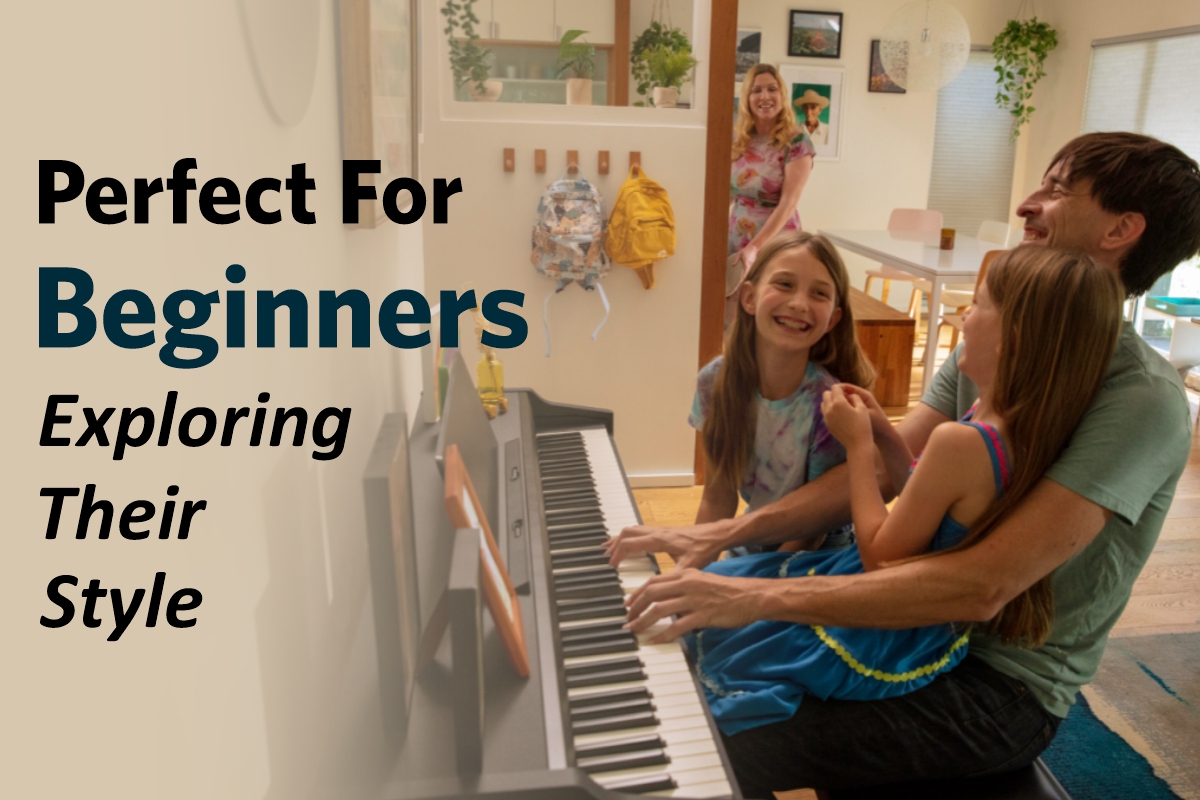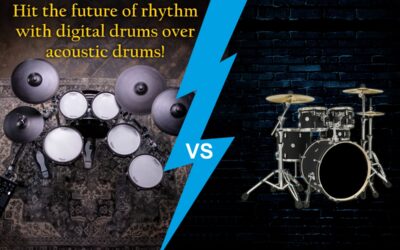Buying your first piano can be hard, especially because there are so many brands to choose from. If you don’t know much about music, it can be even more confusing.
When I worked in the music instrument industry, I met many people, especially parents, who wanted to buy a piano for their kids. It was usually the first piano for their home, which made it a special moment for the family. They wanted to make sure they were making the right choice.
So, it was important for me to help them choose the right piano, considering what they wanted and how much money they had to spend. I think it’s the best way to help people buy a piano.
Step One: Acoustic Or Digital?
Choosing a piano depends on what the family wants. Ideally, everyone would love to have a big, beautiful acoustic piano, but that’s not always possible.
An entry-level acoustic piano costs more than a digital one. But it’s not just about the initial price. Acoustic pianos need regular tuning and maintenance, which can be expensive. Tuning can cost between Rs. 3500 to Rs. 6000 each time. You also need a humidifier or dehumidifier depending on the weather.
Moving an acoustic piano is hard and needs professionals, which costs more money. Moreover, as an acoustic piano gets older, its sound quality can get worse. It’s also tough to find trained technicians and parts for acoustic pianos in India.
But if a family is ready to spend money on maintaining an acoustic piano, it’s not a bad choice.
Digital pianos have improved a lot in the past few years. They sound almost as good as acoustic pianos and have cool features like headphones, recording, Bluetooth, and lots of different sounds. With headphones, you can practice quietly without bothering anyone and let’s agree a happy neighbor is one less thing to worry about.
Some digital pianos can connect to apps, which makes learning and playing even more fun.
But in most cases, parents choose digital pianos because they’re easier to take care of and cost less in the long run.
Step Two: Key factors to look for in a piano
Let’s understand the basic factors which one must look for in a piano.
- Sound
- Keyboard
- Damper Pedal
For this article we will look at Roland digital pianos. They have set the standard for high quality, affordable instruments for the home.
Sound:
Almost all Roland pianos use SuperNatural Piano Technology which makes its piano sound very expressive and responsive like acoustic pianos.
Roland’s SuperNatural Piano Technology is based on three basic principles:
- 88 Key Sampling – Roland Piano sounds are sampled from premium concert grand. Most of the digital pianos use sample zones which give similar character to the same group of notes. Roland on the other hand samples all 88 notes which gives distinct character to each note just like an acoustic piano. So tonal changes according to the key range is very smooth and natural.
- Seamless Tonal Variation – Typical digital piano uses 3 to 4 different waveforms for different dynamic range for each key. This results in abrupt change when the piano player plays pianissimo to fortissimo. SuperNATURAL Piano on the other hand does not have any sound gap. Sound changes very smooth and organic. And dynamic range is also wider than conventionally sampled pianos.
- Natural Tone Decay – In traditional digital pianos the decaying part of the sample is looped giving the tone a very unnatural effect. Roland on the other hand lets the sample fade away naturally just as in acoustic piano giving its piano tone a smooth and natural decay.
| S.No | Model | Super Natural Piano Technology |
|---|---|---|
| 1 | Roland FP-E50 | Yes (With ZEN-Core) |
| 2 | Roland F107 | Yes |
| 3 | Roland FP-10 | Yes |
| 4 | Roland FP-30X | Yes |
| 5 | Roland FP-60X | Yes |
| 6 | Roland RP-107 | Yes |
| 7 | Roland RP-501R | Yes |
| 8 | Roland RP-701 | Yes |
Keyboard:
- Roland has many types of piano keys which they have developed over the years. They have Hybrid Grand Keyboard, PHA50, PHA4 and Ivory Feel Key.
- Progressive Hammer Action IV [PHA4] keyboard replicates the feel of an acoustic piano wherein the lower keys have a slightly heavier feel than the higher keys. PHA-4 Standard Keyboard delivers every nuance whether you play hard or soft captured by Roland’s touch-detection technology. With high-resolution sensing and escapement for fast key repetition, the keyboard faithfully translates into sound the subtlest differences in dynamics and tone.
- The Ivory feel keys give you almost the exact feel of the ancient ivory keys which were more responsive and less likely to “stick” to one’s fingers because of perspiration that may accumulate while one is playing a particularly difficult piece.
- Roland keys also uses the escapement technology. You feel a slight click in your fingers while playing an acoustic piano because of the hammer action. The similar feel is replicated in Roland pianos.
| S.No | Model | Keyboard |
|---|---|---|
| 1 | Roland FP-E50 | PHA-4 Standard Keyboard: with Escapement and Ivory Feel |
| 2 | Roland F107 | PHA-4 Standard Keyboard: with Escapement and Ivory Feel |
| 3 | Roland FP-10 | PHA-4 Standard Keyboard: with Escapement and Ivory Feel |
| 4 | Roland FP-30X | PHA-4 Standard Keyboard: with Escapement and Ivory Feel |
| 5 | Roland FP-60X | PHA-4 Standard Keyboard: with Escapement and Ivory Feel |
| 6 | Roland RP-107 | PHA-4 Standard Keyboard: with Escapement and Ivory Feel |
| 7 | Roland RP-501R | PHA-4 Standard Keyboard: with Escapement and Ivory Feel |
| 8 | Roland RP-701 | PHA-4 Standard Keyboard: with Escapement and Ivory Feel |
Damper Pedal
- There are various types of Damper Pedals a.k.a Sustain Pedals available for digital pianos.
- In an acoustic piano the level of sustain increases as you press the pedal. Same behaviors is available in pianos which have pedal with continuous detection. Some of the pianos have half pedal detection i.e one would get two level of sustain. Third type of damper pedal is an on / off pedal i.e the sustain effect is switched off and on.
| S. No. | Model No. | Pedal |
|---|---|---|
| 1 | Roland FP-E50 | Continuous Detection |
| 2 | Roland F107 | Continuous Detection |
| 3 | Roland FP-10 | Half Pedal Detection |
| 4 | Roland FP-30X | Continuous Detection |
| 5 | Roland FP-60X | Continuous Detection |
| 6 | Roland RP-107 | Continuous Detection |
| 7 | Roland RP-501R | Progressive Damper Action |
| 8 | Roland RP-701 | Progressive Damper Action |
Other Important Features:
Number of Tones:
- The biggest advantage of a digital piano is that it offers wide range of tones. The user has the advantage of being able to switch from one genre to another. For instance, for Church music, Organ sounds are mostly used and for orchestral music string sounds are highly preferred.
| S. No | Model No. | Number of Tones |
|---|---|---|
| 1 | Roland FP-E50 | 1018 |
| 2 | Roland F107 | 324 |
| 3 | Roland FP-10 | 36 |
| 4 | Roland FP-30X | 321 |
| 5 | Roland FP-60X | 358 |
| 6 | Roland RP-107 | 324 |
| 7 | Roland RP-501R | 316 |
| 8 | Roland RP-701 | 324 |
Twin Piano:
- This function is very useful in the teaching scenario. With press of a button the keyboard gets converted into two identical key ranges. The pedals also work separately for the each key range. The Left pedal works for the left key range and the right pedal works for the right key range. This is to enable the teacher and the student play on the same piano as though they are playing on two different pianos.
| S. No | Model No. | Twin Piano |
|---|---|---|
| 1 | Roland FP-E50 | Yes |
| 2 | Roland F107 | Yes |
| 3 | Roland FP-10 | Yes |
| 4 | Roland FP-30X | Yes |
| 5 | Roland FP-60X | Yes |
| 6 | Roland RP-107 | Yes |
| 7 | Roland RP-501R | Yes |
| 8 | Roland RP-701 | Yes |
Headphone Jack:
Almost all digital pianos come with headphone jack option. For students and beginners it’s always better if the piano has two headphone jacks – 1 for the student and another for the teacher. Most Roland pianos have 2 headphone jacks
App Connectivity:
Roland has developed interactive apps which are compatible with its various models. The apps unlock various potentials of the piano. Roland’s apps can be downloaded from here.
Conclusion:
It would be wise to conclude that modern digital pianos have many advantages over acoustic pianos as they offer versatility without compromising on the quality and the experience of piano playing.



0 Comments